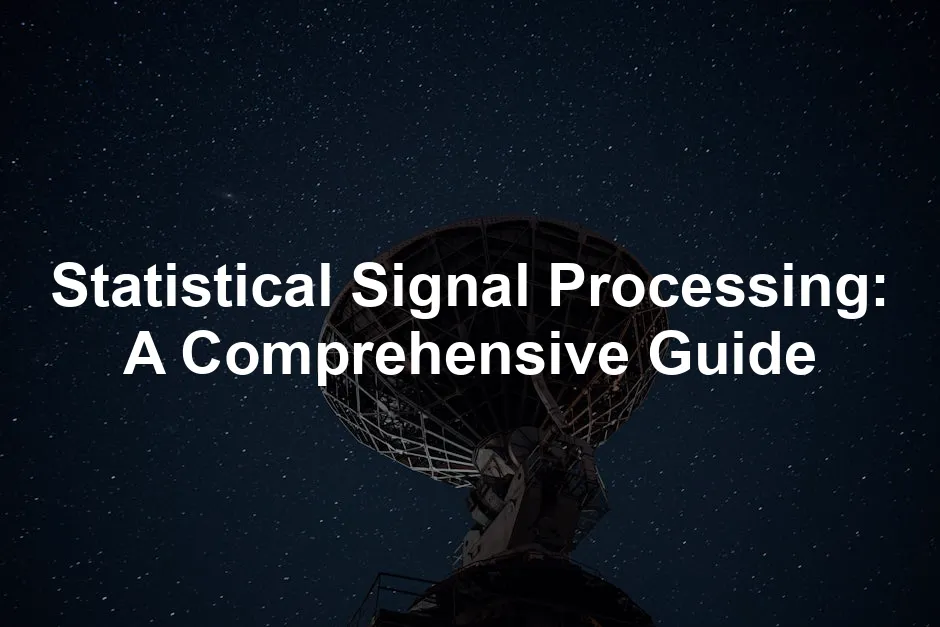Introduction
Statistical signal processing is a fascinating crossroads of engineering and applied mathematics. It focuses on analyzing signals as random processes. Imagine trying to make sense of a chaotic world where signals often arrive with a side of noise—this field thrives on that challenge!
Why is it significant? Well, it empowers engineers to extract meaningful information from signals that are less than perfect. Whether it’s a whisper in a noisy room or an image blurred by interference, statistical signal processing turns chaos into clarity.
Applications? Oh, they’re everywhere! In communications, it helps reduce noise in wireless transmissions. In biomedical engineering, it analyzes heartbeats and brainwaves. Image processing? You bet! It enhances your selfies and makes your favorite movies look stunning. And if you want to dive deeper into the subject, consider checking out Digital Signal Processing: A Practical Approach.
This article aims to provide a detailed exploration of statistical signal processing. Buckle up as we navigate its techniques, applications, and the magic behind the numbers!

What is Statistical Signal Processing?
Definition and Overview
Statistical signal processing is all about treating signals as stochastic processes. Unlike traditional signal processing, which often assumes signals are deterministic, this approach embraces randomness. It focuses on the statistical properties of signals—think mean, variance, and beyond.
By modeling signals as random variables, engineers can apply various statistical methods to analyze and interpret them. This is crucial because real-world signals are rarely perfect. They come with noise and uncertainties that can obscure important information. For those looking to understand these concepts in depth, Understanding Digital Signal Processing is a fantastic resource!
Statistical signal processing bridges the gap between raw data and meaningful insights. It transforms chaotic signals into structured information we can understand and utilize.
Importance in Modern Applications
Why should we care about statistical signal processing? The answer lies in its ability to tackle the messy nature of real-world signals. Take telecommunications, for example. Signals traveling through the air are often corrupted by noise. Statistical methods help filter out that noise, ensuring clear communication.
In radar systems, statistical signal processing plays a crucial role in detecting objects. By analyzing the statistical properties of reflected signals, engineers can distinguish between actual targets and noise. If you’re interested in learning more about radar systems, Introduction to Radar Systems is a great read!
From medical devices analyzing ECG signals to enhancing images in digital cameras, the importance of this field is undeniable. It’s a vital tool that powers breakthroughs across various industries, making our lives easier and more connected.
So, whether you’re chatting on your phone, getting your heart checked, or capturing memories with your camera, statistical signal processing is working behind the scenes, making it all possible!

Historical Context and Evolution
Origins of Signal Processing
Signal processing has roots that stretch back to the 17th century. Early pioneers like James Gregory and Isaac Barrow laid the groundwork with their mathematical formulations. However, it was Claude Shannon who revolutionized the field in 1948. His groundbreaking paper, “A Mathematical Theory of Communication,” established fundamental theories that underpin modern information systems.
Shannon introduced concepts of information theory, treating signals as carriers of information. His work also emphasized noise management, crucial for effective communication. This laid the foundation for both classical and statistical signal processing.
In the decades that followed, the field evolved significantly. Traditional signal processing primarily focused on deterministic signals. Engineers sought to modify and analyze these signals, often overlooking their inherent randomness. Statistical signal processing emerged to address this gap, treating signals as stochastic processes. This shift allowed researchers to utilize statistical methods to extract meaningful insights from noisy data, making sense of the chaos. If you’re keen on diving into the theoretical aspects, check out An Introduction to Statistical Signal Processing by John G. Proakis.
Key Milestones
Several key milestones marked the journey of statistical signal processing. One of the most notable developments was the introduction of Kalman filtering in the 1960s. This technique became essential for estimating the state of a dynamic system from noisy measurements. It’s widely used in applications ranging from aerospace to finance. If you’re curious about practical applications, grab a copy of Kalman Filter: A Practical Approach.
Another significant advancement was the formalization of estimation theory. Techniques like maximum likelihood estimation and Bayesian estimation became crucial for drawing inferences from incomplete data. This allowed engineers and statisticians to make educated guesses about the underlying processes generating the signals.
Over time, the integration of statistical methods into signal processing transformed the landscape. The rise of digital technology in the 1980s further propelled the field forward. With the advent of powerful computing tools, researchers could process vast amounts of data efficiently. This opened doors to new applications, including image processing, telecommunications, and biomedical engineering.
Today, statistical signal processing continues to evolve. Researchers are exploring cutting-edge techniques, including deep learning and machine learning, to further enhance the analysis of complex signals. As our world becomes increasingly data-driven, the importance of statistical signal processing is more significant than ever, ensuring we can glean insights from the noise.

Fundamental Concepts of Statistical Signal Processing
Stochastic Processes
In statistical signal processing, understanding stochastic processes is fundamental. These processes are mathematical models that describe systems influenced by random variables. Essentially, they help us understand how signals behave over time.
Stochastic processes play a vital role in modeling signals, particularly in real-world situations where noise is prevalent. By characterizing signals as stochastic, engineers can apply statistical methods to analyze their properties. This leads to more accurate interpretations and predictions. If you’re curious about practical applications of these concepts, consider checking out Machine Learning for Signal Processing.
Types of Stochastic Processes
1. White Noise: This is a random signal with a constant power spectral density. It’s akin to the static you hear on a radio when it’s not tuned to a station. White noise is crucial in testing and calibrating systems, as it provides a baseline.
2. Poisson Processes: These processes model random events occurring independently over time. Imagine a queue at a coffee shop; the arrival of customers can be modeled as a Poisson process. It’s particularly useful in telecommunications and network traffic analysis.
3. Markov Chains: These are stochastic processes where the future state depends only on the current state, not on the previous states. Think of it as a game of chess; your next move depends solely on your current position, not your entire game history. Markov chains find applications in various fields, including finance and machine learning.

Detection and Estimation Techniques
Detection and estimation techniques are cornerstones of statistical signal processing. They allow us to make sense of noisy signals and extract valuable information.
Parameter Estimation
Two prominent techniques are maximum likelihood estimation and Bayesian estimation.
– Maximum Likelihood Estimation (MLE): This method estimates parameters by maximizing the likelihood function. It’s like finding the best-fitting curve for your data points. MLE is widely used in fields like economics and engineering.
– Bayesian Estimation: This approach incorporates prior knowledge and updates beliefs based on new data. It’s akin to adjusting your expectations based on the most recent information. Bayesian methods are particularly useful in situations where data is sparse or uncertain.
Hypothesis Testing
Hypothesis testing is another critical aspect. The Neyman-Pearson test is a popular method for determining whether to accept or reject a hypothesis based on data. It’s like a courtroom trial, where you weigh evidence to reach a verdict. This technique finds applications in various fields, including medical diagnostics and quality control. For those interested in diving deeper into statistical methods, Statistical Signal Processing: Detection, Estimation, and Time Series Analysis is a solid choice!
In summary, the fundamental concepts of statistical signal processing revolve around understanding stochastic processes and applying detection and estimation techniques. These concepts empower engineers and researchers to navigate the complexities of real-world signals, turning noise into meaningful insights.

Filtering Techniques
Filtering is vital in statistical signal processing. It helps separate the signal from noise. Think of it as a magical sieve that allows only the good stuff to shine through! Effective filtering enhances data quality and improves the accuracy of subsequent analyses.
Kalman Filtering
Kalman filtering is a powerful tool. It estimates the state of a dynamic system from noisy measurements. Picture a GPS trying to pinpoint your location. It constantly refines its estimate based on incoming data, adjusting for uncertainties.
In essence, the Kalman filter predicts where you should be and corrects itself when reality disagrees. It’s widely used in navigation systems, robotics, and finance. For instance, in autonomous vehicles, this filter continually processes sensor data to ensure smooth operation. Its ability to fuse data from multiple sources increases accuracy and reliability, making it a cornerstone in various applications. If you want a deeper understanding of this topic, Digital Signal Processing with MATLAB Examples could be beneficial!
Adaptive Filtering
Adaptive filtering takes a different approach. It adjusts its parameters based on incoming data. This flexibility is crucial in environments where signal properties change frequently. Two popular methods in this realm are Least Mean Squares (LMS) and Recursive Least Squares (RLS).
– Least Mean Squares (LMS): This algorithm minimizes the error between the desired signal and the output. It’s like a dog trainer adjusting commands based on the pup’s response. LMS is simple and computationally efficient, making it suitable for real-time applications.
– Recursive Least Squares (RLS): RLS is more complex but offers faster convergence. It continually updates its estimates to maintain high accuracy. Imagine trying to keep a straight line while riding a bike on a bumpy road—RLS adapts swiftly to maintain balance.
Adaptive filters are essential in telecommunications and audio processing. They excel in noise cancellation systems, enhancing the quality of sound and communication. By dynamically adjusting to changing conditions, they ensure clarity amidst chaos. If you’re interested in more about this subject, consider reading Noise Reduction Techniques in Electronic Systems.
In summary, filtering techniques like Kalman and adaptive filtering are fundamental to statistical signal processing. They empower engineers to extract meaningful insights from noisy data, ensuring that the signal shines bright above the noise!

Other Fields
Statistical signal processing has a diverse range of applications beyond the typical domains. In control systems, it helps manage and optimize system behavior under uncertain conditions. Think about a robot adjusting its actions based on unpredictable surroundings—statistical methods ensure it doesn’t crash into walls!
Sonar systems also benefit from this field. By analyzing reflected sound waves, statistical techniques improve object detection underwater. So, next time you’re on a boat and hear the sonar ping, know that statistical signal processing is working hard to keep you safe!
Seismic signal processing is another fascinating area. It aids in analyzing signals from earthquakes, allowing scientists to predict tremors and assess structural integrity. This application is vital for disaster preparedness—because who wouldn’t want to know when the ground might shake? Learn more about the applications of statistical methods in various fields.

The applications of statistical signal processing extend to various fields, including finance. Statistics vs Dynamical Systems: Applications for Finance Professionals provides insight into how these techniques are utilized in finance.
Challenges and Future Directions
Current Challenges
Navigating the world of statistical signal processing isn’t without its hurdles. One of the most pressing challenges is the prevalence of noise in real-world environments. Imagine trying to hear a conversation at a rock concert; that’s how signals can feel in noisy atmospheres. Engineers must develop algorithms that can effectively filter out this noise while retaining the essential information.
Another significant challenge is the demand for real-time processing. In many applications—like autonomous vehicles or medical monitoring systems—decisions need to be made in the blink of an eye. Traditional algorithms often struggle to keep pace, leading to delays that could have serious consequences. The quest for faster, more efficient processing methods is an ongoing battle!

Future Trends
What does the future hold for statistical signal processing? Buckle up, because it’s about to get exciting! One of the most promising trends is the integration of machine learning and artificial intelligence. These technologies can analyze vast amounts of data and adapt to changing conditions with remarkable speed.
Imagine a system that learns from previous signals, constantly improving its accuracy. This could revolutionize areas like telecommunications and medical diagnostics, where precision is paramount. Machine learning algorithms can identify patterns and anomalies in data, enhancing detection and estimation capabilities. If you’re looking to get started with machine learning, Introduction to Machine Learning is a great place to start!
Additionally, the rise of big data presents both opportunities and challenges. As more devices connect to the internet, the volume of data generated will soar. Statistical signal processing will play a crucial role in managing this data deluge, ensuring we can extract actionable insights without getting lost in the noise.
In summary, the convergence of statistical signal processing with cutting-edge technologies like machine learning is transforming the landscape. As challenges persist, innovative solutions will continue to emerge, paving the way for a future where signals are understood more clearly and quickly than ever before.

Conclusion
In this journey through statistical signal processing, we’ve uncovered its significance and applications across various fields. From enhancing communication systems to analyzing seismic signals, its impact is undeniable. We learned about the challenges posed by noisy environments and the urgent need for real-time processing.
Emerging trends, particularly the integration of machine learning, promise to reshape the future of this field. By harnessing advanced technologies, we can expect significant improvements in how we process and understand signals. If you’re keen on exploring more about data handling, The Data Warehouse Toolkit: The Definitive Guide to Dimensional Modeling is a must-read!
Statistical signal processing is not just a technical discipline; it’s a vital component of modern technology. Its methods empower engineers and researchers to glean insights from the chaos of real-world signals. As we continue to innovate and tackle challenges, the potential for advancements in this area remains vast.
So, the next time you send a message or enjoy a crisp audio experience, remember the magic of statistical signal processing at work. It’s the unsung hero making our connected lives clearer, safer, and more enjoyable!
FAQs
What is the difference between statistical signal processing and traditional signal processing?
Statistical signal processing and traditional signal processing differ primarily in their approach to signals. Traditional signal processing often treats signals as deterministic. This means they assume signals can be predicted exactly, like a clock ticking away. On the other hand, statistical signal processing embraces the unpredictable nature of signals. It treats them as stochastic processes, which means they are subject to randomness. Think of it this way: if traditional signal processing is like a well-rehearsed play, statistical signal processing is more like improvisational theater, where anything can happen! In summary, traditional methods focus on precise signals, while statistical methods focus on understanding and making predictions about noisy, random signals. This distinction is crucial in fields where uncertainty is part of the game.
What are some common algorithms used in statistical signal processing?
Statistical signal processing leverages several algorithms to analyze and interpret signals. Here are a few common ones: – Kalman Filters: This algorithm is a superstar in estimating the state of a dynamic system from noisy measurements. Imagine a GPS refining its location based on shaky signals—Kalman filters do just that! – Particle Filters: These are used for nonlinear and non-Gaussian processes. They track the probability distributions of a system’s state. Think of it as a group of tiny particles, each representing a possible state, floating around until they converge on the right answer. – Maximum Likelihood Estimation (MLE): This technique estimates parameters by maximizing the likelihood function. It’s like finding the perfect fit for your favorite jeans—MLE helps find the best parameters for the data. – Bayesian Estimation: This method updates the probability of a hypothesis as more evidence becomes available. It’s like adjusting your expectations after hearing new gossip—Bayesian estimation keeps things fresh and relevant! These algorithms are just the tip of the iceberg, but they illustrate the innovative techniques used to make sense of the randomness in statistical signal processing.
How can I start learning about statistical signal processing?
Ready to jump into the world of statistical signal processing? Here are some excellent resources to get you started: – Textbooks: – “Fundamentals of Statistical Signal Processing” by Steven M. Kay is a classic. It covers estimation theory and detection methods comprehensively. – “Probability, Random Variables, and Stochastic Processes” by Athanasios Papoulis provides a solid foundation in the necessary mathematical concepts. – Online Courses: – Check out MIT OpenCourseWare for courses like “Stochastic Processes, Detection, and Estimation.” It’s like having a free professor at your fingertips! – Coursera and edX also offer courses related to signal processing—perfect for learning at your own pace. – Research Papers and Journals: Skim through journals like the IEEE Transactions on Signal Processing for the latest advancements. It’s a great way to stay updated! These resources will arm you with the knowledge you need to tackle statistical signal processing head-on.
What role does software play in statistical signal processing?
Software plays a pivotal role in statistical signal processing, acting as the toolbox for engineers and researchers. Here’s how: – MATLAB: This software is a favorite among engineers. It provides built-in functions and toolboxes specifically designed for signal processing tasks. Think of it as your Swiss Army knife for coding! – Python: With libraries like NumPy and SciPy, Python has become a go-to for data analysis and signal processing. It’s user-friendly and perfect for those who prefer a more flexible coding environment. – R: For statistical analysis, R is a powerhouse. Its extensive packages help analyze the statistical properties of signals effectively. These software tools allow for efficient implementation of algorithms, data visualization, and simulation of signal processing scenarios. In essence, they turn complex theories into practical applications, making the world of statistical signal processing accessible and manageable!
Please let us know what you think about our content by leaving a comment down below!
Thank you for reading till here 🙂
All images from Pexels




